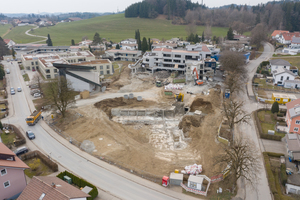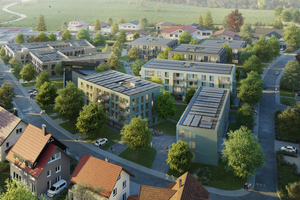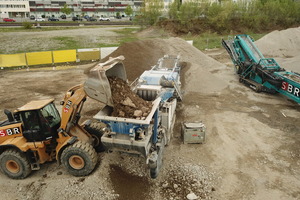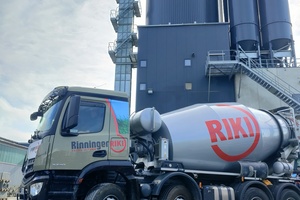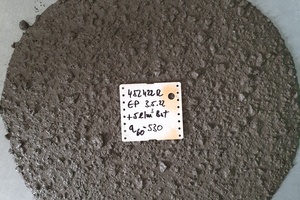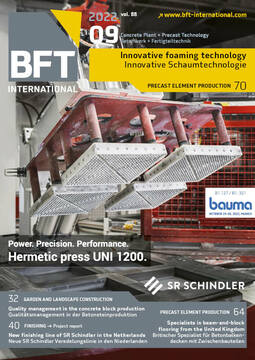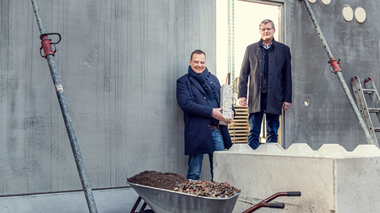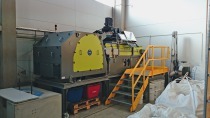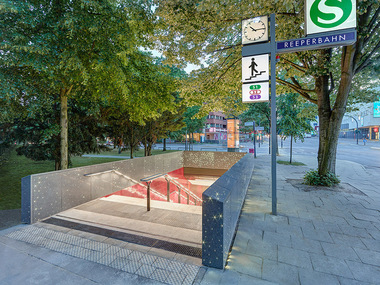Demolition waste becomes raw material
„Recycling is good - recycling on site is better“ - according to this motto, the „Vinzenz Areal“, a social residential quarter with six new buildings, on the premises of a retirement home in Wangen in the Allgäu region, has been under construction since the end of 2021. In demolishing the four-story building, which dates back to the late 1960s, those responsible are pursuing a new approach: instead of reprocessing the concrete waste in a low-grade manner, as is usually the case - for example, in road construction - it is reprocessed on site in a high-quality manner for residential construction. According to the principle of „urban mining,“ the old building serves as a raw materials’ depot to recover and recycle the components and materials used in it.
A pioneering role in the use of resources is played by the construction company Georg Reisch GmbH & Co. KG from Bad Saulgau together with the concrete plant Hans Rinninger u. Sohn GmbH u. Co. KG from Kißlegg. While the Reisch company has developed a process chain that creates an „RC-granulation“ from the demolition material, the concrete plant at Rinninger produces a high-quality recycled concrete. In the current language, one also speaks of R (=resource-conserving) concrete. Sebastian Geiger, responsible for R & D at Reisch, explains the project: „In the greater Stuttgart area, the useage of R-concrete is common practice, but in our region, which is rich in gravel deposits, it has so far only been used to a limited extent. Nevertheless, we initiated this project because we want to make our contribution to saving primary raw materials and landfill space in the long term. In the run-up to the project, numerous laboratory tests were necessary to generate a suitable aggregate from the demolition material that would replace gravel as a raw material in concrete on an equivalent replacement,“ says Geiger.
15.000 t demolished concrete become RC-granulation
On the construction site in Wangen, approx. 15,000 tons of demolished concrete are generated, which have to be processed. A sorting grab and pulverizer are attached to the excavator that carries out the demolition work. These first separate the material by type and then process it into concrete demolition waste, which is initially classified as waste. Samples are also taken and analyzed for chemical parameters that are relevant for the subsequent storage area and later certification.
A brownfield site not far from the construction site was chosen as the location for storage - in order to save CO2 emissions caused by truck transport. A mobile impact crusher of the Kleemann Mobirex EVO type is used on the construction site to produce a so-called „RC-granulation“. „This plant crushes the concrete demolition material into grains with a size between 0 and 22 mm, which are then screened again and sorted into grain fractions,“ explains Geiger. „After this step, the material can be certified into a product and thus loses its waste status again.“
Rinninger plant produces high-quality recycled concrete
The larger particle size group (4 to 22 mm) is then processed into RC concrete at the nearby Rinninger ready-mix concrete plant. As Managing Director Marcus Winterfeld explains: „Because the small fractions from the screened demolition material cannot be used in concrete, the RC aggregate that we collect from the construction site with our vehicles is mixed with natural sand. Water, cement and some admixtures are added. Thanks to our many years of experience in the production of concrete components as well as our expertise in concrete development, we are able to develop a recipe that is precisely tailored to the RC-granulation in question. This results in a recycled concrete that is 100 % suitable for this measure, which is then used in the new construction on the Vinzenz Areal.
In order to produce an equivalent concrete quality, we had to adapt our plants accordingly. In order to save additional CO2, we are also using clinker-reduced cements. This process is still more expensive than conventional concrete production. Nevertheless, we are happy to be involved here because we see it as our duty to conserve resources,“ says Winterfeld.
University in Constance accompanies the project
Does one still wonder what will happen to the smaller groups of grains that come from the demolition? The Reisch company wants to reuse most of them in the Vinzenz project. It can be used, for example, as pipe bedding material for ground pipes and for the development of R-screed (fractions from 2 mm). It is also planned to use the material for floor fill. The construction company intends to find out exactly what is suitable for what purpose in the course of the process; the necessary experience is still lacking here. In this respect, this is also a pilot project. It is also being accompanied by the BI faculty of the Constance University of Applied Sciences Technology, Economics and Design (HTWG). „No matter what comes out of it,“ says Sebastian Geiger, „the material will definitely be reused to the highest possible quality.“
650 tipping semi-trailers of gravel saved
What is already certain, however, is the ecological benefit. 15,000 t of broken concrete will be almost completely recycled. „This saves around 650 tipping semi-trailers of material that does not have to be taken from a natural deposit,“ estimates Winterfeld. „The gravel deposit in the region is thus conserved, landfills are less polluted, and a lot of CO2 is saved by reducing transports. A big and important step in the direction of a circular economy, which the Rinninger company with its 220 employees is happy to go along with.“
Economically critical - ecologically reasonable
The Reisch company also still takes a critical view of the project from an economic point of view: „The whole thing doesn‘t yet pay off,“ says Geiger. „The RC concrete is in no way inferior to conventional concrete in terms of quality, but the costs of producing recycled concrete are currently still too high. From our point of view, however, sustainability and ecology must become so important that it is an indispensable process to initiate such projects today.“
All six new buildings on the Vinzenz site are scheduled to be ready for occupancy in early 2024. Together with the church and St. Vincent‘s inpatient nursing home, they will form a new „social quarter“, with various living concepts, a bundled supply and care offering. With regard to the building materials used, those involved can have a good feeling in any case.
CONTACT
Hans Rinninger u. Sohn GmbH u. Co. KG
Stolzenseeweg 9
88353 Kißlegg/Germany
+49 7563 932-0

